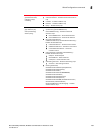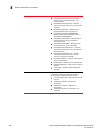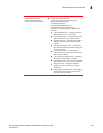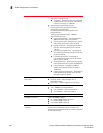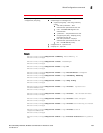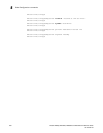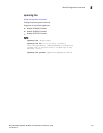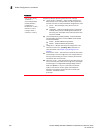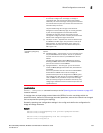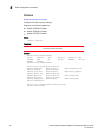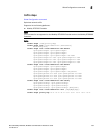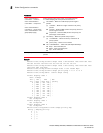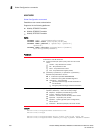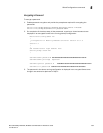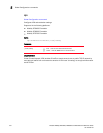
Brocade Mobility RFS4000, RFS6000 and RFS7000 CLI Reference Guide 303
53-1001931-01
Global Configuration commands
5
Usage Guidelines
The
mst > configuration command moves you to the Spanning tree-mst Instance on page 435
Instance instance.
If a bridge does not hear bridge protocol data units (BPDUs) from the root bridge within the
specified interval, defined in the max-age (seconds) parameter, assume the network has changed
and recomputed the spanning-tree topology.
Generally, spanning tree configuration settings in the config mode define the configuration for
bridge and bridge instances.
Example
RFController(config)#spanning-tree portfast bpduguard default
RFController(config)#
RFController(config)#spanning-tree mst configuration
RFController(config-mst)#
• max-age <6-40> – Max-age is the maximum time in seconds
for which (if a bridge is the root bridge) a message is
considered valid. This prevents the frames from looping
indefinitely. The value of max-age must be greater than twice
the value of hello time plus one, but less than twice the value
of forward delay minus one.
The permissible range for max-age is 6-40 seconds.
Configure this value sufficiently high, so a frame generated
by root can be propagated to the leaf nodes without
exceeding the max-age. Use this command to set the
max-age for a bridge. This value is used by all instances.The
default value of bridge max-age is 20 seconds
• max-hops <7-127> – Specifies the maximum allowed hops
for a BPDU in an MST region. This parameter is used by all
MST instances. To restore the default value, use the no
parameter with this command. The default maxhops in a
MST region is 20
portfast
[bpdufilter|bpduguard]
default
Enables the portfast feature on a bridge. It has the following
options:
• bpdufilter default – Use the bpdu-filter command to set
the portfast BPDU filter for the port. Use the
no parameter
with this command to revert the port BPDU filter value to
default.
The Spanning Tree Protocol sends BPDUs from all ports.
Enabling the BPDU Filter feature ensures PortFastenabled
ports do not transmit or receive BPDUs
• bpduguard default – Use the bpdu-guard command to
enable the BPDU (Bridge Protocol Data Unit) Guard feature
on a bridge.
Use the
no parameter with this command to disable BPDU
Guard. When the BPDU Guard is set for a bridge, all
portfast-enabled ports of the bridge that have BPDU guard
set to default shut down the port on receiving a BPDU. In this
case, the BPDU is not processed. The port can be brought
back up manually (using the no shutdown command), or by
configuring a errdisable-timeout to enable the port after the
specified interval



